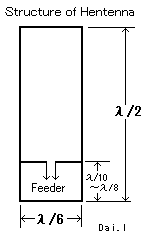About the antenna named Hentena
Have you heard the name of the antenna named Hentena? Operation is a strange antenna though it is an antenna with a strange name. However, the performance is a quite good antenna.
What is Hentena?
Hentenna is one type of antenna. As the name "Strange Antenna" is. And change what you say, even if slightly different size top, middle, or off of the element is deformed to be working fine. It is such a horizontally polarized antenna, but a long vertical.
History of Hentena
Yutaka Someya 1 (JE1DEU) designed the principle in 1972, and development was done centering on ham club "Sagami club". Afterwards, various improvements are added with the hand of a lot of radio hams. It is an antenna designed worldwide in famous Japan between the radio hams.
Feature of Hentena

It is composed of a rectangular loop element of about 1/6 wavelength by about 1/2 wavelength the vicinity of length, it shifts more than the center in the vicinity of length, and the antenna that there is a feeding point in one point for each. The adjustment of the match need not do by changing the position of the feeding point, and adjust the length of the element basically.
Even if the structure is easy, it is efficient. It is a character characteristic of eight almost near omnidirectional though the horizontal plane directivity has the null point from the direction of the maximum radiation in the right and left 90 degrees in a structural antenna like left figure because of the horizontally-polarized wave. Moreover, a gain of Hentena forward is ratio about 3.0[dBd] of the half wavelength dipole. The gain seems to correspond to Yagi Antenna of four elements. Then, a vertical directivity is sharp (low radiation corner).
Space required for installation can be narrow because of the horizontally-polarized wave, and because the mast of the metal can be used for the center of Hentena, this structural Hentena can be easily set up. I often used it because of the movement operation of 50MHz (6m). It has used it also for the antenna of the personal radio of about 900MHz.
Adjusting method of Hentena
It is SWR (Standing Wave Ratio) to make it accurately To minimize this, the position of the feeding point is adjusted measuring the standing-wave ratio with the meter. However, it is a good point hurried operating even if it suitably makes it.
There is the best point around of about 20-25% (λ/10-λ/8) from the vertical element of λ/2 under at the position of the feeding point when connecting it with the power feeder of 50Ω in my experience. I think that I can put out a hurried performance even if it suitably makes it referring to this value when there is no SWR meter.
Method of feeding power Hentena
Hentena is an equilibrium antenna as well as the dipole aerial. Therefore, it is not so good that the coaxial cable of no equilibrium ties directly. However, there seems to be no big problem even if tying directly on practical use.
Balun is handled to convert no equilibrium into equilibrium. For Balun, it is Spertopf using the coaxial cable (bazooka match) and U Balun (1:4 compared with impedance) are handled well. When the frequency is low, even Balun who used the ferritic core thinks it is acceptable.
Application of Hentena
- The one that the upper half of Hentena was cut out includes the one named Fork-hentena. Because height becomes half of Hentena, this might be effective in a low frequency though operation is a little different from Hentena it.
- The one that two elements of Fork-hentena under λ/4 were installed is a kind of Hentena. This is called H-Hentena.
- After Hentena is sideways knocked down, the λ/2 part can be transformed to round. Thus, the electric wave can be launched well though the electric wave changes into the vertically-polarized wave. This is a kind of Hentena. It is called Hat-hentena.